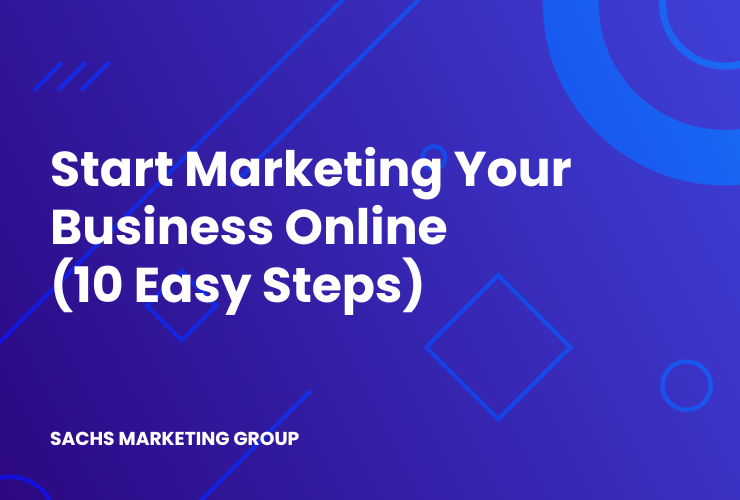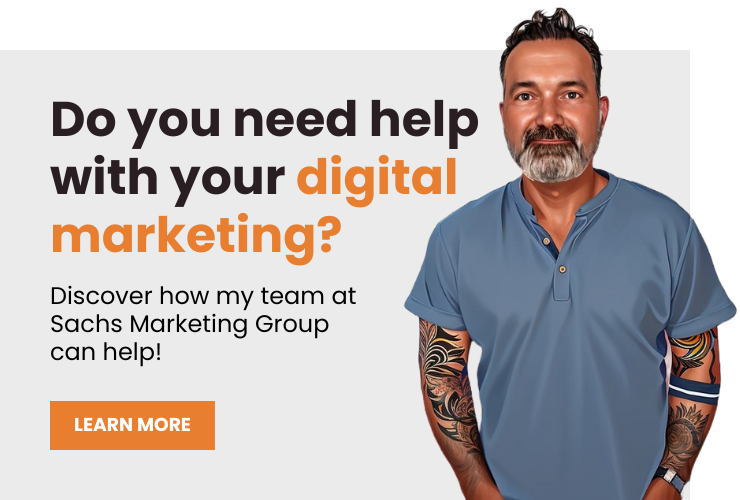You can market your business online by leveraging various digital channels such as search engines, social media, email, and content marketing. Employing a multi-faceted strategy helps reach a wider audience and increases the chances of converting leads into customers.

Marketing your business online can be a daunting task. With so many platforms and strategies to choose from, it’s easy to feel overwhelmed.
Digital marketing is a cost-effective way to reach your target audience and grow your business, and we’re here to help you get started. Whether you dive in and DIY your way through these or opt to hire a digital marketing agency that offers digital marketing services, these steps will guide you in the right direction.
In this article, you will discover how to start marketing your business online in 10 easy steps.
Overview
10 Steps to Marketing Your Business Online
In today’s digital age, marketing your business online isn’t just an option – it’s a necessity. From SEO to social media advertising, there are multiple avenues to explore.
Here’s what you need to know about marketing your business online effectively, step-by-step.
1. Identify Your Target Audience
Identifying your target audience is foundational to any successful marketing strategy. It involves researching and compiling a set of characteristics, behaviors, and motivations that define the people most likely to be interested in your product or service.
This isn’t just a matter of defining broad demographics like age or gender – it’s about drilling down into more specific traits like spending habits, interests, lifestyle choices, and online behaviors. The more detailed you are, the more focused your marketing efforts can be, allowing you to create tailored messaging that speaks directly to the needs and desires of your potential customers.
Once you’ve identified your target audience, it’s crucial to keep this information up-to-date. Markets evolve, and staying attuned to those changes can offer you a competitive advantage. Keep revisiting your customer profiles, conduct periodic surveys, and track analytics to ensure your marketing is hitting the mark.
For example, if you run a fitness studio offering specialty classes like aerial yoga, your target audience could be individuals aged 25-45, primarily women, with a high level of interest in fitness and well-being, possibly with a higher-than-average income level to afford specialty classes. With this specific information, you can better tailor your marketing materials, promotional offers, and even the classes you offer to meet the needs and interests of your target audience.
2. Set Clear Objectives
Setting clear objectives is like drawing a roadmap for your marketing efforts. A lack of clear objectives often results in inefficient spending and a scattergun approach to marketing tactics.
Goals should be SMART:
- Specific
- Measurable
- Achievable
- Relevant
- Time-bound
Specificity adds a layer of accountability, measurability allows for assessment, achievability keeps ambitions realistic, relevance ensures alignment with broader business goals, and time-bound adds urgency.
Once objectives are in place, all actions undertaken in your marketing strategy should align with these goals. Not only do clear objectives help in guiding the tactics, but they also provide a benchmark for success or adjustments.
For example, suppose you run an e-commerce site selling handmade crafts. You could set an objective to increase website traffic by 30% and convert at least 5% of that traffic into sales over the next three months. With this clear, time-bound objective, you can strategize on SEO, content marketing, and paid advertising to reach these specific goals.
3. Choose the Right Platforms
The online world is awash with different platforms and channels where you could potentially market your business, but not all of them will be effective for your specific needs.
The key is to focus your efforts where they are likely to have the most impact. To do this, consider where your target audience is most active and what types of content they engage with on those platforms. For instance, visual products often do well on Instagram, while B2B services may find a more receptive audience on LinkedIn.
Being present on too many platforms can stretch your resources thin and dilute the impact of your marketing efforts. On the other hand, concentrating on a few key channels allows you to focus your efforts and measure the results more effectively.
For example, a marketing agency specializing in digital solutions for healthcare providers may find more success focusing on LinkedIn and specialized healthcare forums rather than spreading their efforts across Twitter, Facebook, and Instagram. Here, they can post articles, case studies, and testimonials that are specifically tailored to attract healthcare decision-makers.
4. Develop a Content Strategy
A content strategy serves as the backbone for all your marketing communications. It defines the type of content you will create, the platforms you’ll utilize, and the audience you aim to reach. A well-developed content strategy also aligns with your overall business objectives and provides a roadmap for what kind of content will be published, when, and where. It enables you to create cohesive, consistent messaging and offers a plan for effectively utilizing different types of content like blog posts, videos, podcasts, or infographics to meet your goals.
Before you start creating content, identify your unique selling proposition (USP) and think about how it solves a problem or meets a need for your target audience. Content that offers valuable insights solves problems, or engages an audience emotionally is more likely to be shared and acted upon. Keep a calendar and establish a cadence for publishing. This will help you maintain consistency, which is vital for building an engaged audience and improving SEO.
For example, a company specializing in outdoor gear may develop a content strategy around providing practical tips for camping, hiking, and outdoor survival. They may create weekly blog posts, monthly how-to videos, and daily social media updates sharing little tips and tricks, all aimed at a target audience of outdoor enthusiasts. Each type of content serves a specific purpose and works together to establish the brand as a trustworthy resource in the outdoor space.
5. Search Engine Optimization (SEO)
SEO is a critical component of digital marketing that helps improve your website’s visibility on search engines. It involves a variety of strategies such as keyword research, content optimization, backlink acquisition, and technical improvements to your website. An effective SEO strategy can significantly increase organic traffic, lead to higher conversions, and improve brand credibility. With search engines constantly evolving, it’s crucial to keep abreast of the latest SEO guidelines and algorithm updates to maintain or improve your search rankings.
Start by conducting a thorough keyword analysis to identify terms that are relevant to your business and that potential customers might use when looking for your products or services. Optimize your site’s content and meta descriptions for these keywords. Don’t forget about local SEO if your business has a local component. Use tools like Google Analytics to regularly track your performance.
For example, a dental practice wanting to attract more local clients may identify key search terms like “family dentist [city name]” or “emergency dental care [city name].” They may optimize their homepage and service pages with these search terms, create blog content around dental care, and ensure their local listings are accurate to improve their search engine rankings.
6. Paid Advertising (PPC)
Paid advertising offers a way to quickly drive targeted traffic to your website. Platforms like Google Ads and social media sites allow you to target specific demographics or search intent, thereby increasing the chances of conversion. While paid advertising requires an upfront investment, it can offer a good ROI if done correctly. When launching paid campaigns, it’s crucial to align your advertising goals with your overall marketing objectives.
Start by setting a budget and specifying the KPIs you will use to evaluate success. Perform A/B tests to determine which ads are most effective and adjust your campaigns accordingly. Regularly track your performance and be ready to tweak your campaigns to optimize ROI.
For example, an online apparel store might run a Google Ads campaign targeting search queries like “summer dresses” or “men’s swimwear.” By setting parameters like geography, age, and interests, they can ensure their ads are displayed to the most relevant audience. Monitoring click-through rates and conversions will help them adjust the ad copy, images, or target demographics to optimize the campaign’s effectiveness.
7. Social Media Marketing
Managing your brand’s social media presence is more than just posting updates on Facebook or Twitter. It’s about creating a community around your brand, engaging with your audience, and providing valuable content that resonates with them. Social media platforms allow for a two-way communication channel where businesses can also gain insights into consumer behavior, preferences, and pain points. A strong social media marketing strategy can result in higher brand awareness, more robust customer relationships, and increased sales.
Develop a content calendar that aligns with your brand’s voice and objectives. Use this to schedule regular posts across the platforms most relevant to your audience. Keep an eye on key metrics such as engagement rate, follower count, and return on investment (ROI) to gauge the effectiveness of your strategy. This will allow you to tweak your future campaigns for better performance.
For example, a bakery might use Instagram to showcase high-quality images of their baked goods, share behind-the-scenes stories of the baking process, and run occasional promotions or contests. By measuring metrics like engagement rates and ROI, they can identify which types of content resonate most with their audience and adjust their strategy accordingly.
8. Email Marketing
Email marketing remains one of the most effective channels for digital marketing, boasting high engagement rates and ROI when done right. It allows for targeted messaging and provides an excellent platform for nurturing leads and maintaining a connection with existing customers. From newsletters and promotional offers to new product announcements, email marketing can serve various functions.
It’s crucial to segment your email list to provide more targeted, personalized content. Use tools to track metrics like open rates, click-through rates, and conversion rates to understand how well your email campaigns are performing. This data will guide your future email marketing strategies.
For example, a software-as-a-service (SaaS) company might send out monthly newsletters with industry insights and tips on using their product more effectively. They could also segment their list to send specialized onboarding emails to new customers and retention offers to long-term clients.
9. Monitor Analytics
Monitoring analytics is the linchpin for any successful digital marketing strategy. This is where you gather the data that will inform every other aspect of your plan, from which channels are driving the most traffic to what kind of content is generating the most engagement. Without this data, you’re essentially marketing blindfolded.
Regularly review key performance indicators (KPIs) relevant to your business objectives. Analytics tools for digital marketing like Google Analytics 4, Facebook Insights, and specialized email marketing software offer comprehensive data analytics features. Use this data to refine your strategies and make more informed decisions.
For example, an e-commerce website might look at metrics such as page views, bounce rates, and conversion rates to identify potential bottlenecks in the customer journey. Using these insights, they can then optimize their site for better performance and higher conversions.
Here are 7 Google Analytics 4 (GA4) metrics you should track to get started.
10. Hire a Digital Marketing Agency
For businesses that lack the time or expertise to manage their digital marketing, hiring an agency can be a wise investment. Agencies bring specialized knowledge and resources to the table that can help scale your marketing efforts and drive tangible results. They offer a range of services, from SEO and paid advertising to social media management and content creation, all designed to increase your online presence and achieve your business objectives.
When choosing a digital marketing agency, look for one that has experience in your industry and can demonstrate a track record of success. Make sure their services align with your business needs and budget. Remember, the goal is a long-term partnership that will grow your business over time. Be sure to ask questions before partnering, as their answer may reveal whether or not a collaboration would be a good fit for your business – here are 18 questions to ask a digital marketing agency.
For example, a real estate agency looking to enhance its online visibility might hire a digital marketing agency specializing in the real estate industry. The agency could overhaul the website for better SEO, run targeted ad campaigns, and manage social media profiles to attract and engage potential buyers and sellers.
Partner with Sachs Marketing Group
Are you struggling with marketing your business online?
Sachs Marketing Group is a trusted full-service digital marketing agency that offers a wide range of services tailored specifically to help your business reach its goals and succeed.
Imagine seeing your website traffic double and your conversion rate skyrocket, all because you’ve employed a personalized, multi-channel strategy.
Don’t miss out on the opportunity to transform your online presence. Contact Sachs Marketing Group today for a free consultation.
Conclusion
Marketing your business online may seem complicated, but it becomes manageable when you break it down into steps. By following the guidelines mentioned in this article, you’ll be well on your way to building a strong online presence and achieving your business goals.
Contact us today to get the conversation started!














